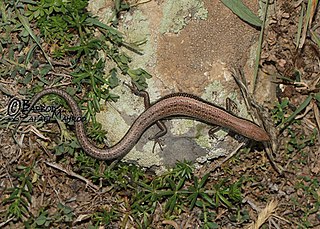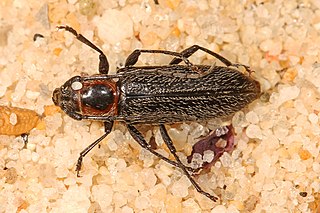Related Research Articles

The Burmese python is one of the largest species of snakes. It is native to a large area of Southeast Asia and is listed as Vulnerable on the IUCN Red List. Until 2009, it was considered a subspecies of Python molurus, but is now recognized as belonging to a distinct species. It is an invasive species in Florida as a result of the pet trade.

Python molurus is a large, nonvenomous python species native to tropical and subtropical regions of the Indian subcontinent and Southeast Asia. It is known by the common names Indian python, black-tailed python, Indian rock python, and Asian rock python. It is generally lighter colored than the Burmese python and reaches usually 3 m (9.8 ft).

Python is a genus of constricting snakes in the Pythonidae family native to the tropics and subtropics of the Eastern Hemisphere.

The slippery dick is a species of wrasse native to shallow, tropical waters of the western Atlantic Ocean.

The spotted free-tailed bat is a species of bat in the family Molossidae. It is found in Burundi, Djibouti, Eritrea, Ethiopia, Kenya, Mozambique, Rwanda, South Sudan, Tanzania, Uganda, Zambia, and Zimbabwe. Its natural habitats are dry savanna, moist savanna, and rocky areas.

The twin-striped skink is a skink native to Armenia, Azerbaijan, Turkmenistan, northwestern Iran and Turkey. It is generally found at elevations between 2,300 metres (7,500 ft) and 3,300 metres (10,800 ft).

Melanoplus bivittatus, the two-striped grasshopper, is a poikilothermic species of grasshopper belonging to the genus Melanoplus. It is commonly found in North America, with high quantities inhabiting Canadian prairies and farmland.

Urgleptes is a genus of longhorn beetles of the subfamily Lamiinae. It was described by Dillon in 1956.

Stenosphenus is a genus of beetles in the family Cerambycidae, containing the following species:
Eryphus is a genus of beetles in the family Cerambycidae, containing the following species:
Glyptoscapus is a genus of beetles in the family Cerambycidae, containing the following species:
Stenosphenus bivittatus is a species of beetle in the family Cerambycidae. It was described by Giesbert and Chemsak in 1989.
Eryphus bivittatus is a species of beetle in the family Cerambycidae. It was described by Melzer in 1934.
Glyptoscapus bivittatus is a species of beetle in the family Cerambycidae. It was described by Gounelle in 1909.

Hemilophini is a tribe of longhorn beetles of the subfamily Lamiinae.
Urgleptes bivittatus is a species of beetle in the family Cerambycidae. It was described by Gilmour in 1961.
Lamacoscylus bivittatus is a species of beetle in the family Cerambycidae. It was described by Charles Joseph Gahan in 1892. It is known from Mexico.
Mexicoscylus is a genus of longhorn beetles of the subfamily Lamiinae, containing the following species:
Mexicoscylus nigritarse is a species of beetle in the family Cerambycidae. It was described by Galileo and Martins in 2013. It is known from Costa Rica.
Mexicoscylus rosae is a species of beetle in the family Cerambycidae. It was described by Martins and Galileo in 2011. It is known from Mexico.
References
- ↑ Mexicoscylus bivittatus at World Cerambycidae.